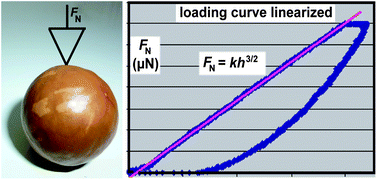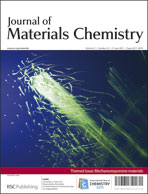Nut or seed hardshells' mechanical response is studied by vertical nanoindentation in the untreated surface with pyramidal tips. As in uniform materials the exponent of the loading curves is also determined to be 3/2 (but not 2 as Hertzian theory would predict) in all of the nanocomposites with correlation coefficients r > 0.999 (except two cases with r > 0.996 due to minor distortions) for the linear plots with slope k (µN nm−3/2). Unlike hardness H and reduced elastic modulus Er, the pyramidal nanoindentation coefficient k reflects the total mechanical response. It allows for depth calculations according to FN = kh3/2. Thus, the k-values represent the penetration resistance, and k−1 represents the penetratability. Importantly, the penetration depth h follows FN2/3 but not FN1/2 what Hertzian theory had been claiming, despite the importance for wear, mar, mechanical treatments, and tribology. A quantitative mechanical rating is now possible for the first time. The values of k can be converted to different tip tapers. Reliable and repeatable vertical indentations with sharp cube corner were achieved by approaching sufficiently flat summit sites on the rough surfaces under AFM control. The surfaces were not previously destroyed by microtome cutting or abrading and polishing. Detailed knowledge of the architectures of the shells' sclerenchyma was obtained by 3D optical microscopy in color of clean natural surfaces and on fresh fracture surfaces in different directions. Multiple layers, fibrous structures in various alignments and several types of almost isodiametric cells were differentiated. The linearity of the FNversush3/2 plots secures uniformity of the thick-walled cells notwithstanding initial minor deviations due to nanoroughness and surface layers. Comparison with published bone and nacre data is added and discussed. The nanomechanical response of unidirectional indentation at the cellular level influences the cracking resistance of the whole nuts/seeds, but the higher level of wood hierarchy has often the higher weight. The various stabilization tools governing the elastic and brittle responses towards the bending forces that apply upon cracking of the nuts/seeds with their different sizes and shapes are discussed on the basis of the structural data. Importantly, the combination of the mechanical and structural results reveals four new bionics models. These are possible improvements of Yacoe-Davis type dome constructions by stiffeners between the polygons, hedgehog effect for highly elastic materials by efficient interlocking, ellipsoidal cell effect for highly inelastic products, and vertical nanofiber arrays for highly light absorbing very dark surfaces.

You have access to this article
 Please wait while we load your content...
Something went wrong. Try again?
Please wait while we load your content...
Something went wrong. Try again?


 Please wait while we load your content...
Please wait while we load your content...